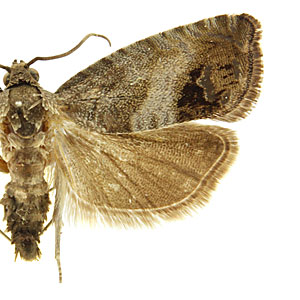Adult Recognition

FWL: 6.5-10.5 mm
Forewings are light gray to gray. The distal one-third of the wing is marked with a dark-brown to black subtriangular patch that surrounds the purplish ocellus. Hindwings are dark grayish brown.
Adults may appear similar to those of other Cydia species. Cydia kurokoi is very similar but only occurs in Asia. Cydia fagiglandana is darker overall and lacks a well-defined purplish ocellus. Cydia pomonella is a more uniform gray and the ocellus is edged with gold or copper scales. A genitalic dissection can be used to confirm identity of the species listed here.
Larval Morphology

For information on the larva of Cydia splendana, please consult the fact sheet and keys on LepIntercept - An identification resource for intercepted Lepidoptera larvae.
Biology

Cydia splendana completes a single annual generation. Adults are present in June to July in Central and Northern Europe and August to September in Southern Europe.
Females lay eggs singly on young fruit or on leaves near fruit. Early instars tunnel into fruit and feed inside and a single fruit generally supports one larva. Larval-infested fruit drop to the ground early. Overwintering occurs as a late instar lava under bark or in the soil. Pupation occurs the following spring.
Host plants
Larvae of Cydia splendana are important pests of chestnut (Castanea sativa). Other preferred hosts include Quercus, Fagus, and Juglans.
| Family | Genus/species | Common name |
| Fagaceae | Castanea Mill. | chestnut |
| Fagaceae | Castanea sativa Mill. | European chestnut |
| Fagaceae | Fagus sylvatica L. | European beech |
| Fagaceae | Quercus L. | oak |
| Fagaceae | Quercus petraea (Mattuschka) Liebl. | durmast oak |
| Fagaceae | Quercus robur L. | English oak |
| Fagaceae | Quercus rubra L. | red oak |
| Juglandaceae | Juglans L. | walnut |
Distribution

Cydia splendana is widely distributed thoughout Europe. Records from Asia are likely of a different species (see Cydia kurokoi).
References

Bogenschutz, H. 1991. Eurasian species in forestry, pp. 673-709. In L. P. S. van der Geest and H. H. Evenhius [eds.], Tortricid Pests: Their Biology, Natural Enemies, and Control. World Crop Pests, Vol. 5. Elsevier, Amsterdam.
Bradley, J. D., W. G. Tremewan and A. Smith. 1979. British Tortricoid Moths - Tortricidae: Olethreutinae. The Ray Society, London, England. 336 pp.
Brown, J. W. and Komai, F. 2008. Key to larvae of Castanea-feeding Olethreutinae frequently intercepted at U.S. ports-of-entry (Lepidoptera : Tortricidae). Tropical Lepidoptera Research. 18(1): 2-4.
Meijerman, L. and S. A. Ulenberg. 2000. Arthropods of Economic Importance: Eurasian Tortricidae. Arthropods of Economic Importance series. ETI/ZMA.
Razowski, J. 2003. Tortricidae of Europe, Vol. 2, Olethreutinae. Frantisek Slamka, Slovakia. 301 pp.
Photo Credits

Fig. 8: Gyorgy Csoka, Hungary Forest Research Institute, Bugwood.org









